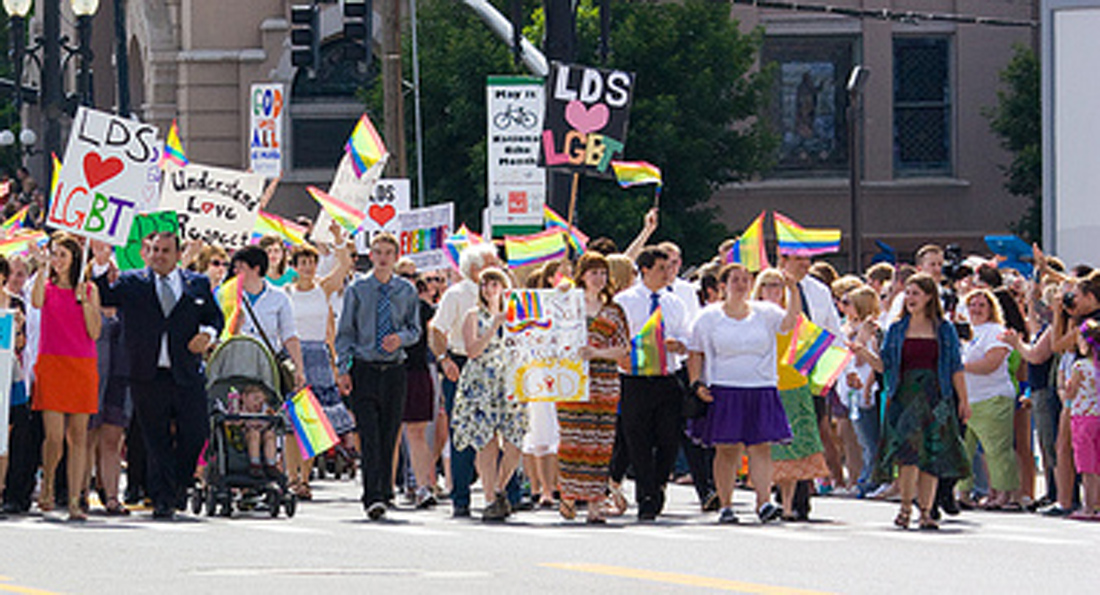By Meghan Tribe
Brad Steckelberg assumed everyone knew he was gay. A recent convert to The Church of Jesus Christ of Latter-day Saints – colloquially referred to as the Mormon church—Steckelberg disclosed his homosexuality prior to his baptism. He understood the church’s stance on celibacy. He was willing to live within those parameters. But that became close to impossible once people in the church started setting him up with women.
A younger church member passed along Steckelberg’s email address and phone number to his mother. Another church member’s sister found Steckelberg’s email from the church directory and began emailing him. A missionary asked Steckelberg if he could give his phone number to a woman he baptized in another area, for as he put it, “she and I would be perfect together.”
Perplexed and dumbfounded, Steckelberg reached out to his friend and missionary in the Pure Branch of The Church of Latter-day Saints in Pierre, South Dakota, for guidance. Steckelberg said his friend’s haunting advice to him was, “No matter what you do, keep this a secret. Do not tell anyone about your attractions. And I’m just telling you for your own good, that it won’t end well if you start telling people.” Steckelberg’s friend identified the underlying irony of the Mormon Church’s alleged shift on homosexuality.
In January 2015, Mormon elders held a press conference where they called upon local, state and federal governments to pass legislation “protecting the rights of our LGBT citizens in such areas as housing, employment and public accommodation,” so long as these rights didn’t infringe on the constitutional rights of churches or the integrity of the traditional family outlined in Mormon doctrine.
To some, this signaled a change in the treatment and acceptance of LGBT Mormons. But to others, this was simply a red herring, only offering support for non-discrimination policies outside the church, so long as they gained protection in the guise of religious exercise to discriminate within it.
“Over six thousand of us around the world are more than pleased to hear [this] announcement,” said Kendall Wilcox, co-founder of Mormon’s Building Bridges, a Mormon grassroots group.
The announcement, Wilcox said, was a huge step forward. According to Wilcox, it was an acknowledgement on the part of the Mormon elders of the shifting attitude in congregations toward acceptance of LGBT members, allowing for members of the church to be open to lifestyles of other members, without fear of sanctions or excommunication.
“The Church appears to understand that discrimination is a problem,” said Ed Yohnka, director of communications and public policy for the American Civil Liberties Union. But, “look at what they’ve suggested, [it’s] just another form of discrimination.”
According to Yohnka, the church’s announcement was less centered on the protection of LGBT rights but focused more on the demand for protection for religious believers who discriminate based on sexual orientation. Under the idea of religious freedom proposed in this announcement, landlords could lawfully not rent to a lesbian couple, so long as their decision was based on a religious objection, Yohnka said.
John Gustav-Wrathall, former senior vice-president and current board member of Affirmation, an organization that seeks to support LGBT Mormons, called the announcement a precedent-setting statement that is encouraging to a lot of people. “It put the LDS church on record, at least in principle, supporting civil rights protection,” Gustav-Wrathall said.
Still, he identified that the core challenge of being a homosexual or transgender person within the Mormon church is doctrinal. In order to achieve the highest order of Mormon salvation, “you have to be married and [have] progeny. That is a very central aspect and one of the highest ordinances within the church,” Gustav-Wrathall said. Therefore, not being able to enter into that kind of relationship creates a major existential problem that creates a deep crisis of faith for LGBT Mormons.
Ryan T. Cragun, an associate professor at the University of Tampa who specializes in Mormonism, said that the whole Mormon concept of family is rooted in heterosexual normativity. “How do gay people fit in – they don’t,” Cragun said.
In 1995, Mormon church President Gordon B. Hinckley presented “The Family: A Proclamation to the World.” The Family Proclamation, as it is commonly known, affirms the familial structure within the Mormon church as between a man and a woman. It follows that there can be “no sexual relations outside the bonds of a legal marriage between a man and a woman,” said Paul S. Woodbury, president of the Illinois Chicago Mission. This is known as the law of chastity.
“If they have same gender attraction, they can fully participate in the church, but they have to live by the law of chastity,” Woodbury said. “If they really want to practice this faith and be baptized, they have to abide by these rules.”
Woodbury said people are actually excited to live these lives, comparing the struggle of homosexuals within the Mormon church to someone giving up alcohol. “It frees them from addiction, pains and challenges they may have had in their lives,” Woodbury said.
Dwight Cook, 57, struggled with his homosexuality until he left the Mormon church in 1998. “Before you were quickly dismissed as being evil and lesser,” Cook said. “Now, the attitude is more like, ‘Oh, you’re an alcoholic. We’ll support you through your struggle. You’re still inferior. But we’re not so quick to exclude you and not so quick to put judgment upon you publicly.’ ”

